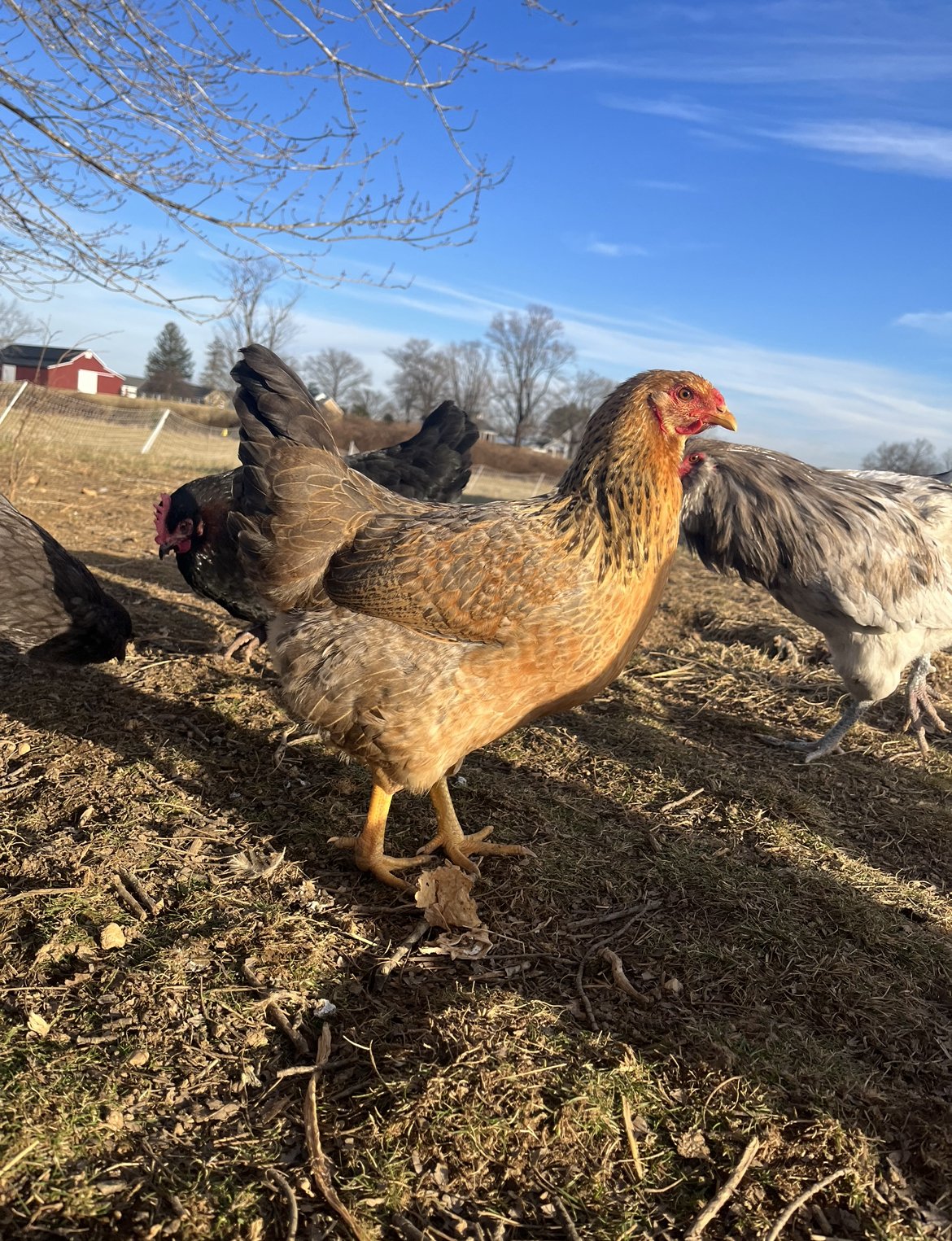Heritage Chickens of the Biocultural Conservation Farm
Rachel Martin
As generations of humans have moved across the globe, they have brought many plants and animals along with them. Grains, roots, leafy greens, paper, plants for dye, livestock, and insects have been traded between civilizations and carried along human migration. Of the livestock species that have traveled in tandem with humanity, chickens stand out for several reasons.
Image via JSTOR.
In the chicken’s early years of domestication from the wild Red Jungle Fowl on the Indonesian Archipelago and in Southeast Asia, it is believed to have been used primarily for entertainment in the form of cock-fighting, so many breeds were developed for traits that would do well in a fight. Cockfighting breeds, commonly called “gamefowl” are still a popular form of chicken breed today. The use of chickens for their eggs and meat was initially an afterthought, a by-product of their recreational and ceremonial uses. For example, the first recorded history of chickens arriving in Egypt were as gifts to the nobility in around 2,000 BC, arriving through trade routes from the Middle East. The exotic birds were kept as gamefowl and status symbols, and it wasn’t until about 1,000 years later that the average Egyptian was raising chickens for eggs and meat.
Like 3,000 years ago, today’s chickens are still bred for their meat, eggs, fighting abilities, and beauty, amounting to about 1,600 unique breeds across the world. Though this sounds like a lot, there is still room in the world for more!
Cub Run Crele Hen. Photo by Nick Sette.
Since 2020, the Biocultural Conservation Farm has been raising two chicken breeds which are local to our region. These are not heritage breeds but brand new breeds developed by Jason Myers Benner of Tangly Woods Homestead in Keezletown, Virginia. The Cub Run Crele and Shenandoah chickens were developed to fit into the specific bioregion of Western Virginia. These birds have been bred by Jason for their ability to withstand the weather extremes of cold winters and hot summers. Characteristics also include the ability to recognize predators and hide from them with camouflaged plumage. More specifically, Jason’s Shenandoah chicken was bred for pasture systems. He writes, “The light brown/tan/buff color range was chosen as the best color for reflecting solar heat gain without attracting the attention of predators as white birds do. Black highlights in hackle and tail, as well as black flecking and penciling on the back feathers have been (selected) to promote reasonable grassland camouflage. As yellow skinned birds with pigmented scales on feet and shanks, the resulting green hue of their feet adds to the grassland camo effect.”
The Shenandoah’s ability to perform on grassland not only fills the bioregional need for grassland ecosystems but also fills the human need of farmers who are looking for a breed to raise on pasture land along with cattle or over future crop fields. In contrast with the grassland-specialized Shenandoah, the Cub Run Crele is more specialized for its human use.
“Rural folks who want a good, hardy, steady, user-friendly, reliable flock of all-around productive chickens, when they come to Tangly Woods seeking their satisfaction, will be pointed to the Cub Run Crele.”
- Jason Myers-Benner
Example of auto-sexing in Bielefelder chicks. The coloring is similar to Cub Rub Crele. Image via Greenfire Farms.
Cub Runs are bred for both egg laying and meat production, perfect for small-scale farm systems and homesteaders. Another important attribute of the Cub Run Crele is their auto-sexing genes, which means that after hatching, male and female chicks are easily distinguishable. Male chicks are hatched light colored with a light dot on their heads, and females are hatched darker with chipmunk coloring. Auto-sexing breeds are important because roosters can be separated early on to be raised for meat separately from hens, and farmers wishing to sell day-old chicks can confidently only sell hens.
At Tangly Woods, Jason is creating these new breeds to fill needs farmers in Virginia may have. Creating an entirely new breed is not the only option though. Many farmers and homesteaders take advantage of already existing heritage chicken breeds and select for traits more useful to them, not worrying about breed standards which mainly focus on looks. Breeding the popular Welsummer chicken over generations to become a more productive egg layer is a route some would say is more attainable than creating an entirely new breed. Many of the heritage breeds we have today come from meddling with other heritage breeds, for example the New Hampshire. The New Hampshire was bred from the egg producing Rhode Island Red to be a larger bodied table/broiler breed, creating a similar looking chicken with a different function. The demand for bioregional and culturally specific breeds of chickens varies everywhere, and there is always room for improved breeding and new breeds to fill those needs. Whether it be improving upon heritage chickens to better fit a farmer’s specific system, or shaping an entirely new chicken designed for a system, the possibilities are endless.
This blogpost was written by our Biocultural Conservation Farm BCCF Landscape Manager, Nick Sette.
If you are interested in learning more about Jason’s work or chicken breeding, registration is open for our two-day Chicken Breeding workshop! Register here.
References:
“Auto-Sexing Chicken Breeds.” Greenfire Farms, 3 July 2020, https://greenfirefarms.com/auto-sexing-chicken-breeds.html.
Adler, Jerry, and Andrew Lawler. “How the Chicken Conquered the World.” Smithsonian Magazine, Smithsonian Institution, 1 June 2012, https://www.smithsonianmag.com/history/how-the-chicken-conquered-the-world-87583657/.
Myers-Benner, Jason. “Cub Run Creles.” Tangly Woods, 25 Apr. 2022, http://tanglywoods.com/chickens/cubrun/.
Myers-Benner, Jason. “Shenandoahs.” Tangly Woods, 25 Apr. 2022, http://tanglywoods.com/chickens/cubrun/.
Lawler, Andrew. How the Chicken Crossed the World?: The Story of the Bird That Powers Civilization. Duckworth Overlook, 2016.
Laatsch, David R. “Origin and History of the Chicken.” Livestock Extension, University of Wisconsin- Madison, https://livestock.extension.wisc.edu/articles/origin-and-history-of-the-chicken/
Publisher: Allen &, et al. Black Frizzled Fowl, from the Prize and Game Chickens Series (N20) for Allen & Ginter Cigarettes. Commercial color lithograph, 1891. <a href="https://www.metmuseum.org/">The Metropolitan Museum of Art</a>, JSTOR, https://jstor.org/stable/community.18380156. Accessed 9 Jan. 2023.



